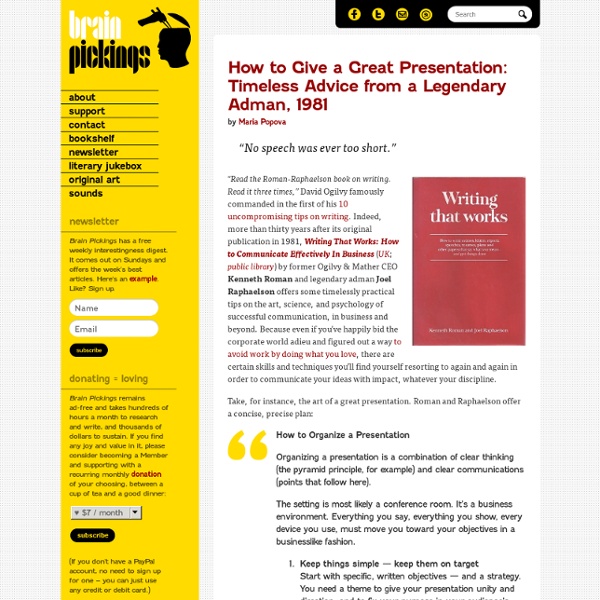Five Presentation Mistakes Everyone Makes - Nancy Duarte
by Nancy Duarte | 2:00 PM December 12, 2012 We all know what it’s like to sit through a bad presentation. We can easily spot the flaws — too long, too boring, indecipherable, what have you — when we watch others speak. The thing is, when we take the stage ourselves, many of us fall into the same traps.
Because science is fun and full of surprises. Follow me @braveneutrino
With the support of my wonderful Team, Working Lunch is underway. After 1 week of operation, I can say that it has potential. To anyone reading this, I would really appreciate your feedback as I work to fine tune this idea to help me create an atmosphere where redos and retakes are not seen by students (an me) a punishment, but an opportunity. (Send me a Tweet @braveneutrino if commenting on the blog isn’t working or is a pain in the neck!) Setting the Stage – Why Now? This week marks the first week of the second semester for my 7th and 8th graders.
The Five Best Tools for Creating Videos Without Installing Software
Over the years I've published some lists and reviews of free tools for creating videos online. Quite a few of those tools have been for creating simple videos that are really just automated, audio slideshows. See Animoto for an example of this.
Daniel Pink
Daniel Pink is the author of the New York Times Bestseller To Sell Is Human: The Surprising Truth About Moving Others. In this interview, we talk about the new ABCs of influencing others, the power of attunement for leaders, and why we are all in sales now. Listen below or subscribe via iTunes. This podcast is supported by Audible.com. Get a free audiobook just for trying it at www.audibletrial.com/lead. Podcast: Play in new window | Download
Twitter for Professional Development: Ultra Beginner Edition, Part 2
Written by Mark Brumley Beyond the Basics In the post Twitter for Professional Development: Ultra Beginner Edition, I offered a simple way to demonstrate the power of Twitter to teachers. If you are introducing Twitter to your colleagues, I highly recommend following that model.
40 Best Fonts for Better Typography Designs
Selecting the best fonts are essential for any image or design. Mostly, they convey important information that are needed for the design. Fonts can either make or destroy the design, so it critical for designers to choose the right font that will correspond to your design. With the numerous fonts we have compiled in our previous post, we have decided to ,yet again, collect valuable fonts if you’re into creating typography designs… 40 Best Free Fonts for Better Typography Designs are collected in this next post just for you. Allow a moment or two to check out the amazing items we have provided here and download the ones that you like..
Prezi – Advantages and Disadvantages by @InstTechTalk
Prezi is a great presentation tool for spicing up the mundane PowerPoint that you’ve been using for the past 10 years. It allows for new kinds of visualizations and opportunities to link imagery to motion, which in turn creates a deeper understanding and retention duration. With any technology, there are advantages and disadvantages that exist.
Five Ways Teachers Can Use Technology to Help Students
The Huffington Post By: Darrell M. West and Joshua Bleiberg



